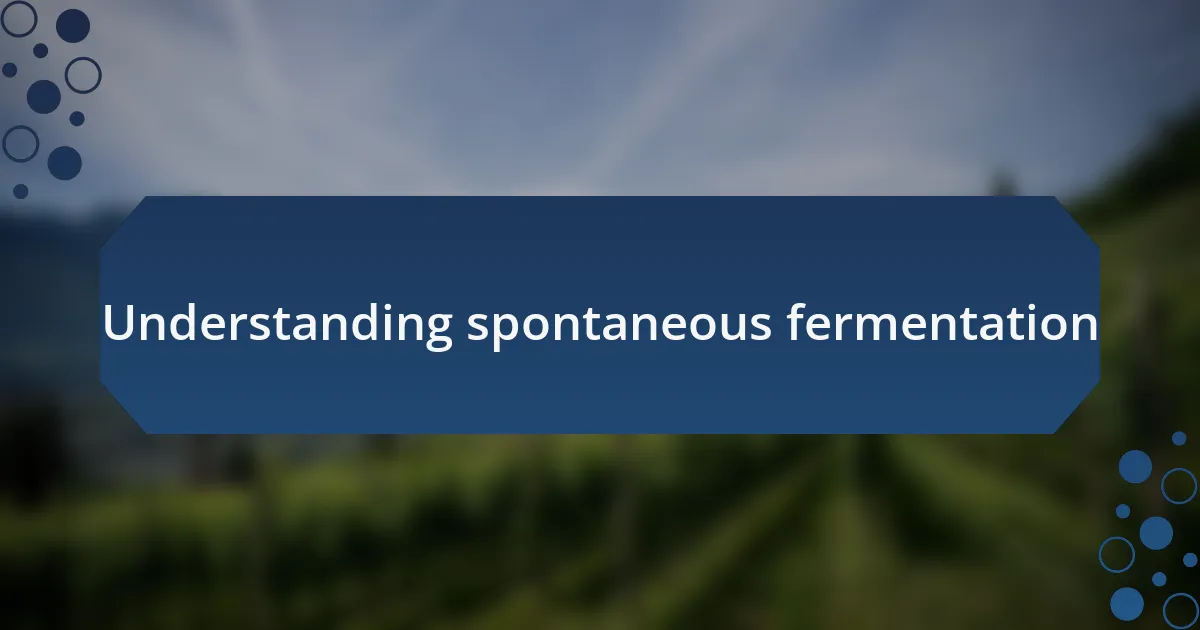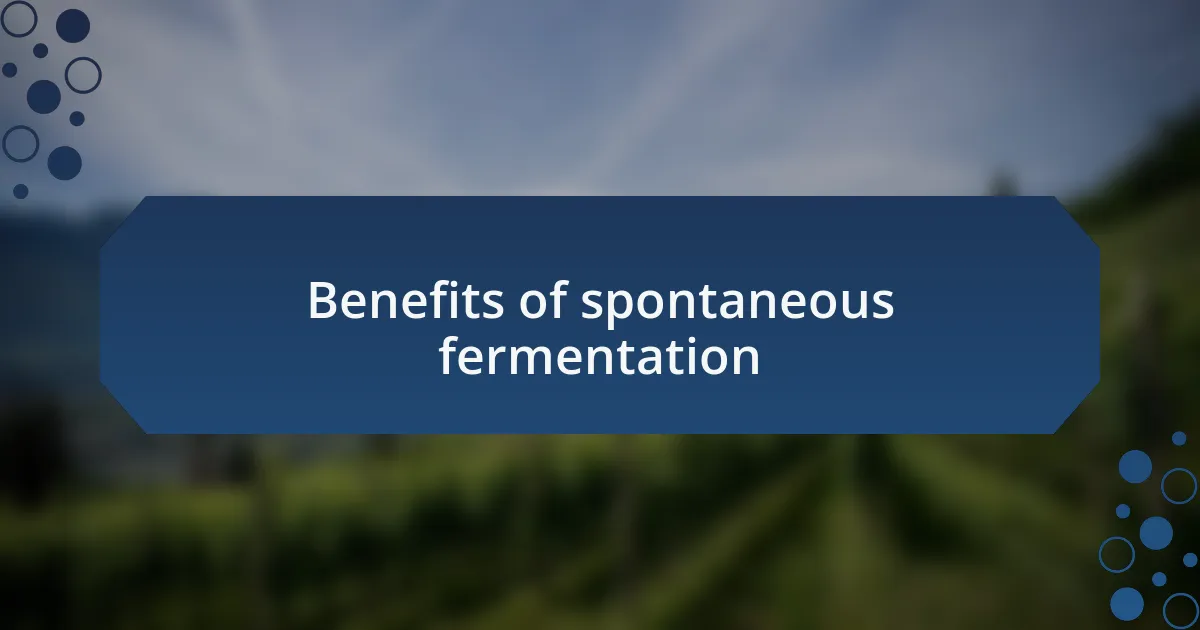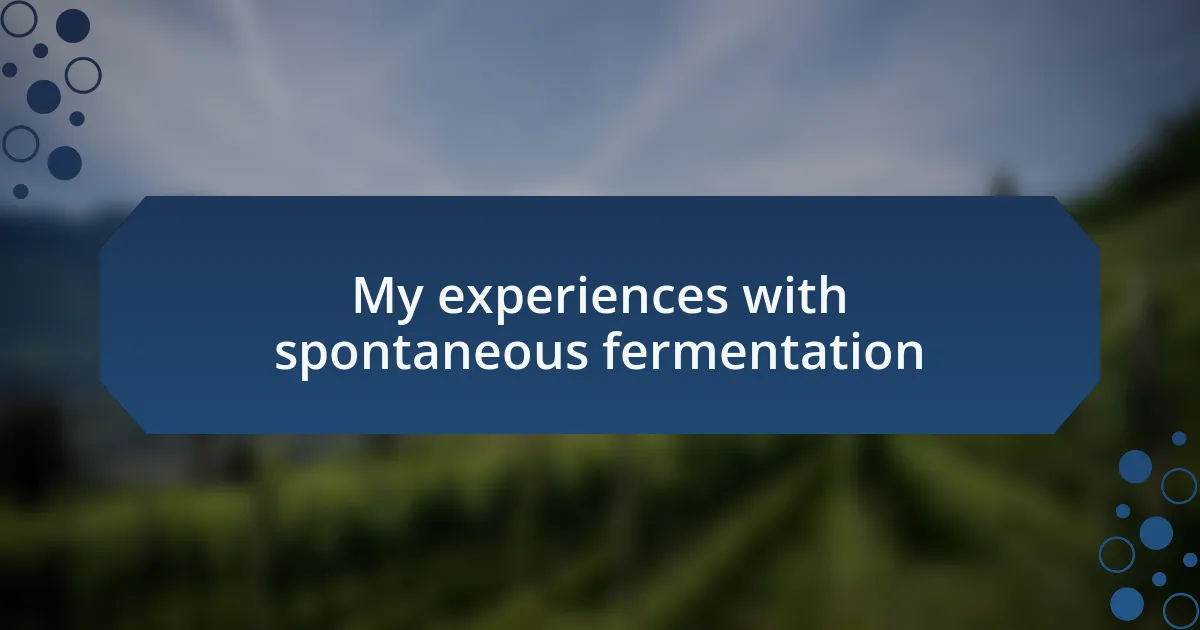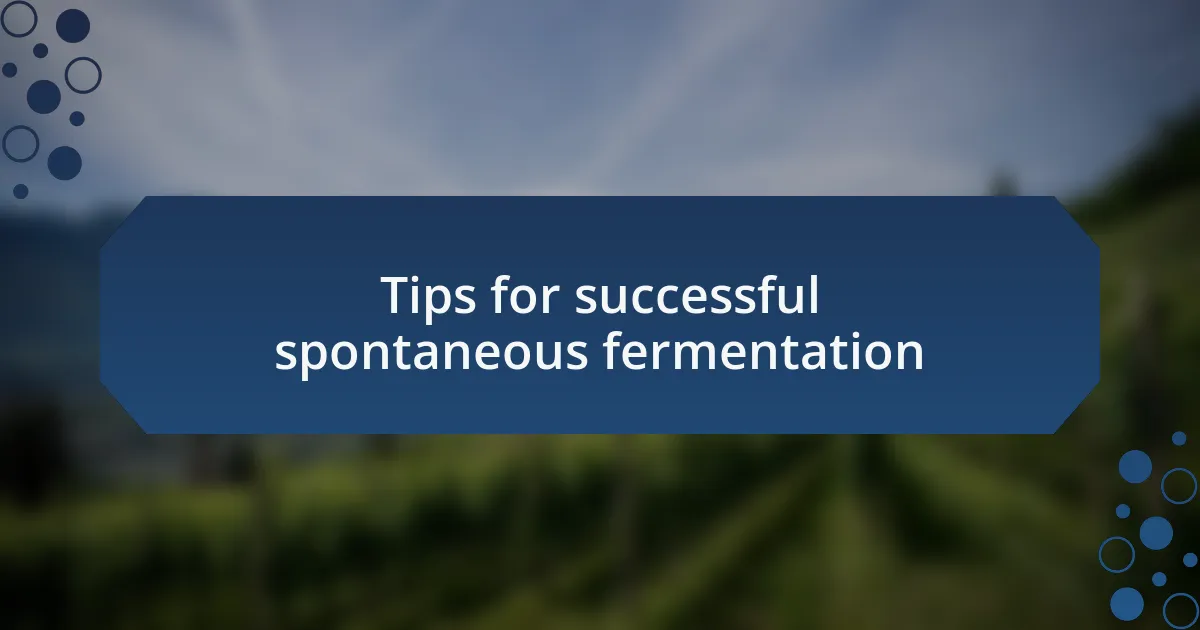Key takeaways:
- Spontaneous fermentation relies on wild yeast, fostering unique and unpredictable flavor profiles that reflect the vineyard’s terroir.
- Organic wine production emphasizes natural cultivation methods, enhancing the connection between the wine, the environment, and the people behind it.
- Challenges in spontaneous fermentation include consistency, spoilage risks, and the need for patience, requiring a delicate balance between authenticity and quality control.
- Successful spontaneous fermentation relies on maintaining vineyard hygiene, monitoring fermentation temperatures, and embracing the natural process with patience.

Understanding spontaneous fermentation
Spontaneous fermentation is a fascinating process where wild yeast naturally present in the environment takes the lead in converting sugars into alcohol. I remember visiting a vineyard where the winemaker proudly shared how he embraces this natural approach, allowing the vineyard’s unique terroir to shape the wine’s character. It sparked a sense of wonder in me: how much influence does nature truly have on the final product?
What I find compelling about spontaneous fermentation is its unpredictability. Each vintage can differ significantly, leading to a more authentic expression of the grapes and the place they come from. Have you ever wondered how such variability might affect a wine’s flavor profile? From my experience, this variance often ignites a deeper appreciation for each bottle; it tells a story of the season, the climate, and the unseen forces at play.
Moreover, this method encourages a more hands-off approach to winemaking, which resonates with my philosophy of letting nature take its course. It challenges the notion of control in production. In my own winemaking attempts, I’ve realized that sometimes, stepping back can lead to surprising, delightful outcomes, embodying a true collaboration with nature.

Basics of organic wine production
In organic wine production, the focus is primarily on cultivating grapes without synthetic pesticides or fertilizers. I recall my initial encounters with organic vineyards, where I was struck by the lushness of the land and the care taken in each step. The joy of seeing grapes thrive naturally made me realize that healthy soil is truly the foundation of extraordinary wine.
What’s fascinating is how the organic approach aligns with sustainable practices, reinforcing the bond between the farmer and the land. I often think about the impact of farming methods on wine quality. It’s enlightening to witness how organic growers prioritize biodiversity, not just for environmental health but also to enhance grape flavors, creating a more vibrant and expressive profile in the finished product.
Moreover, organic certification involves rigorous practices that ensure transparency and traceability. I find that knowing a wine is produced organically adds a certain richness to the drinking experience—a deeper connection to the earth and the people behind it. Have you ever sipped a glass of wine and felt a link to its origins? For me, this enhances not only the flavor but also the enjoyment, as every sip carries the philosophy and dedication of sustainable practices.

Benefits of spontaneous fermentation
Spontaneous fermentation offers a unique connection between the wine and its environment, as it relies on the natural yeasts present on the grape skins and in the vineyard. I remember the first time I tasted a spontaneously fermented wine; it had a complexity that felt alive. The layers of flavor danced across my palate, hinting at the particular terroir—something that commercial yeasts simply can’t replicate. Isn’t it fascinating how nature can create something so intricate without human intervention?
One of the standout benefits of spontaneous fermentation is its contribution to the wine’s individuality. Each vintage can tell a different story based on the yeast strains at play and the conditions of the harvest. When I revisit a bottle from a particular year, I am often struck by how it encapsulates that moment in time—something that feels truly special. Don’t you think that every sip should be an adventure rather than a uniform experience?
Additionally, spontaneous fermentation often leads to a more robust and aromatic wine. There’s a certain richness I find in these wines that comes from the diversity of microorganisms at work during fermentation. I recall a delightful afternoon spent in a small organic winery where the winemaker passionately described how each batch developed its character over time, creating a wine that’s undeniably unique. Can you imagine savoring a wine that feels like a tangible expression of its surroundings? It transforms the act of drinking into a deeper exploration of place and passion.

Challenges of using spontaneous fermentation
Spontaneous fermentation, while intriguing, doesn’t come without its challenges. One of the main hurdles is consistency. I’ve seen firsthand how different environmental factors can greatly affect fermentation outcomes—temperature fluctuations, varying yeast populations, or even the vineyard’s microbiome can lead to unpredictable results. It raises the question: how can winemakers ensure quality when they embrace the wild side of fermentation?
Another significant challenge is the risk of spoilage. Not all indigenous yeasts are beneficial, and I’ve encountered wines that have developed off-flavors due to unwanted microbial activity. It’s a bit nerve-wracking, really; you invest so much time and effort into nurturing those grapes, only to face the possibility that nature might not cooperate. How do you balance the desire for authenticity with the fear of ruin?
Finally, there’s the aspect of time and patience. Spontaneous fermentation often takes longer than its commercial counterparts, which can strain resources and cash flow for small producers. I remember chatting with a winemaker who shared the angst of waiting for nature to take its course, questioning whether they should intervene or let it run its natural path. It’s a delicate dance that requires not just skill but a deep trust in the process. How can one remain committed to spontaneity when the clock is ticking?

My experiences with spontaneous fermentation
Embracing spontaneous fermentation has been one of the most exhilarating yet nerve-wracking experiences in my winemaking journey. I still vividly remember the first time I decided to let nature take the reins; it was a risky move, but the thrill of watching the fermentation unfold was addictive. There’s something deeply satisfying about knowing that my wine’s unique profile is crafted from the very essence of the vineyard itself, but it definitely kept me on my toes.
One particular vintage stands out—a year when wild yeast took a little longer to start working its magic. I found myself pacing the cellar, anxious and second-guessing my decision to forgo commercial yeast. It was in those anxious moments that I learned the value of trust—not just in my instincts, but in the natural processes at play. That wait became a testament to patience, eventually rewarding me with a wine that perfectly embodied the vineyard’s spirit.
I’ve also faced situations where unexpected flavors emerged, transforming my expectations. At times, I’ve been surprised by earthiness or unexpected fruit notes, which left me both delighted and troubled. It raises a compelling question: do we as winemakers risk imperfection in pursuit of authenticity? My journey with spontaneous fermentation continues to teach me that each batch is a lesson, shaping my understanding of both wine and the creative process behind it.

Tips for successful spontaneous fermentation
When diving into spontaneous fermentation, one of the first tips I would emphasize is to maintain optimal vineyard hygiene. I’ve found that a clean environment significantly reduces the risk of wild yeast contamination. It’s fascinating how something as simple as cleanliness can influence the overall outcome. Have you ever noticed how a small flaw can overshadow the most intricate flavors? Keeping your tools and equipment sanitized can really make a difference.
Another essential factor is to keep an eye on the temperature during fermentation. From my experience, a stable temperature range encourages the wild yeast to thrive. I remember one year when fluctuating temperatures led to a sluggish fermentation process. The stress of waiting for fermentation to kick off was intense, and I learned the hard way that being mindful of conditions can save a lot of worry down the line.
Finally, patience is truly a virtue in the realm of spontaneous fermentation. I vividly recall a vintage that, at first, felt like it was dragging on. I had to remind myself that good things take time, and as I stepped back, I watched as the flavors gradually developed beautifully in their own time. It made me wonder, isn’t it remarkable how nature finds its rhythm? Embracing that waiting period can unlock a depth of character in the wine that you might otherwise miss.